Colbalt Server & Strongbolt
by admin on Sep.21, 2007, under IT Adventures
I love making old technology live on some times – today’s bleeding edge is all fine, but give me a nice low-tech solution any day.
Last weekend I had a fun time playing with a server I am picking up from work. I found a Sun Cobalt XTR laying about, forgotten by the flow of time, and it seems to have followed me home. A co-worker and I played around with it at work first, fired it up and ensured it still had a pulse. I decided to toy with it to see if it could fulfill my long held desire of having a RAID file server – a central dumping ground where I can at last place all my completely invaluable files and accumulate even gigs more! My digital pack-rat mentality can finally realize its full innate potential. I can save everything forever – just like that Microsoft guy and his “My Life” project. Or at least have a stable place to back my other systems up to.
So – I brought the box home and it looks like this:
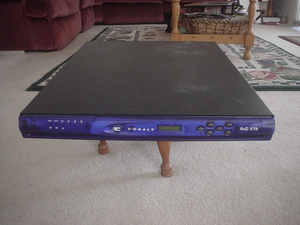
The fun part though is that it holds four drives behind the front pace plate which slides out. The four drives are great and let me use (software) RAID 0, 1 or 5 configurations.
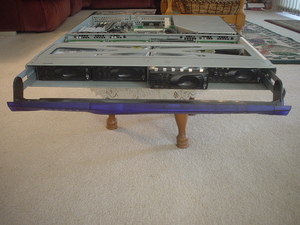
And inside:
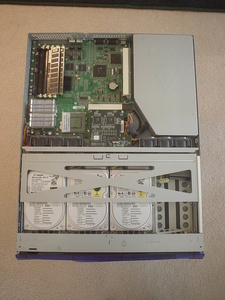
Taking it apart revealed it is actually a dual CPU board, that is cool. I can plop another PIII 933 in it, though it’s not like it will really need it. But hey – I can boast of having yesterdays best technology if I do, so there is a nostalgic higher purpose.
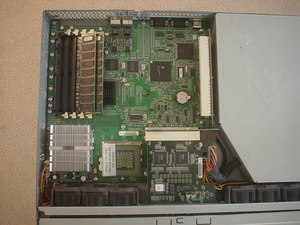
Looking at the back panel – things are a bit bleak. Notice anything missing?
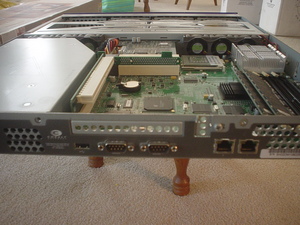
Because there is no video card output is redirected to the serial ports. Using any terminal program you set set it to 115200 bps and viola’ – you have shell access. We checked this out and played with it at work to ensure everything was good and then it came home with me.
Looking around on-line I discovered Sun still had the OS CD image on their site for free download – however it was somewhat antiquated. Researching more yielded a much better solution – Strongbolt, which is CentOS 4.5 + Blue Quatz. Killer.
I downloaded the image and used my notebook connected to the Cobalt via a crossover cable. The Strongbolt install environment is pretty cool, it is just a terminal program to monitor the install, a GUI environment (Knoppix based) and an installer. You boot the Cobalt from the network and the linux environment acts as a DHCP server, assigns the Cobalt the IP and pushes the image to it. Great product and excellent presentation.
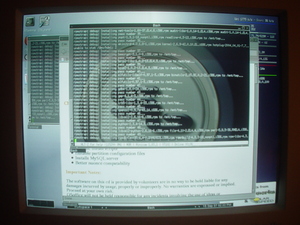
(A very poor image of a very cool thing.)
It worked perfectly, updating the firmware in the process. On first try the web management interface Blue Quartz was not installed. Realized you have to use NIC 1 or it only installs the OS. Reinstalling put on both the OS and the Web interface. Blue Quartz is based on the original Sun source code, which the released open-source in 2003. It is a web style control panel for managing the server, setting up domains, etc – all oriented to web hosting.
Of course after the install I did not need to console it via the serial port, I could just ssh to it.
Now to really make this work though the original 30GB hard drives would have to go. I decided to get a $69 Seagate 320GB drive on sale at CompUSA and slap it in, fully expecting the BIOS limitation of the machine to either not see it or see it at 137GB limit, etc. Imagine my suprise when I rebooted at saw it recognized in its complete 320GB splendor. WOOT! Another quick trip back to CompUSA for another drive yielded me a nice 600GB + of file serving goodness. A nice half terabyte should do me for now, with room to grow of course.
I then lead it back to work and placed it in the employee rack, safe and happy with my other servers – it’s life purpose actualized.
Now its all set to act as my digital redundant repository – I’ll use Back Up PC and also install Torrent Flux both pretty killer apps. Back Up PC allows you to do just that of course, and has clients that will work on Linux, Windows, OS X to create automatic file backups – pretty cool.
My geekness satiated at least temporarily, I moved onto another project . . .
Leave a Reply
You must be logged in to post a comment.
June 22nd, 2009 on 10:54 pm
I came across this, as I have a couple of these units ‘laying around’ and want to make one a file server as well. How did you configure it to be a file server. I have a copy of Strongbolt 1.06, and it appears to be nothing but a web server with some email capabilities. Am I wrong?
Thanks!
Scott
June 23rd, 2009 on 6:43 pm
Hi Scott,
The Strongbolt CD installs a generic CentOS base with the Blue Quartz web control panel. Actually, I believe you can optionally choose to install the web control panel or not – it should prompt you on the LCD panel when the installer runs, so if you don’t want to use it as a web server you will not need that.
If you like you could just install the OS using the live CD onto one drive. Then, you can use the remaining three drives in an LVM or RAID 5, etc. I have an LVM on mine two 320GB drives and room for one more. Since this 1U server accommodates 4 IDE drives so well, and for me at least recognized larger sized drives, using it for a file server is perfect. (You need to compile the dm.ko device mapper kernel module for LVM but it is not that hard, and if you use the same kernel I have I can just email it to you can if the versions are the same it should work fine.)
The install procedure is fairly straight forward – launch the Strongbolt Live CD on one computer (a notebook is perfect) and connect to the RAQ / Cobalt server with both a serial cable (there is no VGA) and a cross-over Ethernet. It is pretty slick really – it will console you via the serial cable in a shell, and setups up itself as a dhcp server and does a network install onto the server. Worked extremely well for me. There is a newer version that installs CentOS 5 as well, though mine is the older 4.6. (Don’t know if the CentOS 5 version has the LVM kernel module or if you would need to compile it. I also compiled the tun module for VPN connections. I use it from running a BackupPC server on it – great use for these boxes.)
Let me know how if goes if you decide to use it.
Cheers,
Pete
September 13th, 2009 on 9:42 pm
I have SB 1.06, but don’t have it installed on the XTRs. I have it running on a Raq4i, so I assume that I could install it on the XTRs as well. I don’t know how to compile stuff for Linux. I’m a noob. 🙁
I assume that what you’re saying is that I could add a drive (say an old 20GB), install the OS, and then add a pair or trio of 320s, configure them as an LVM, and use the three drives in a RAID5 configuration as the storage area for the file server? Why couldn’t I just configure the RAID5 using all four drives and do the same thing, but use 4 drives instead of just the three? Is the LVM required for the file server to operate? Please forgive the silly questions.
Scott
September 13th, 2009 on 9:45 pm
Oh, if you can tell me what kernel you’re using, and I can get hold of the same one, could you walk me through the basic instructions of compiling the module and applying it to the system?